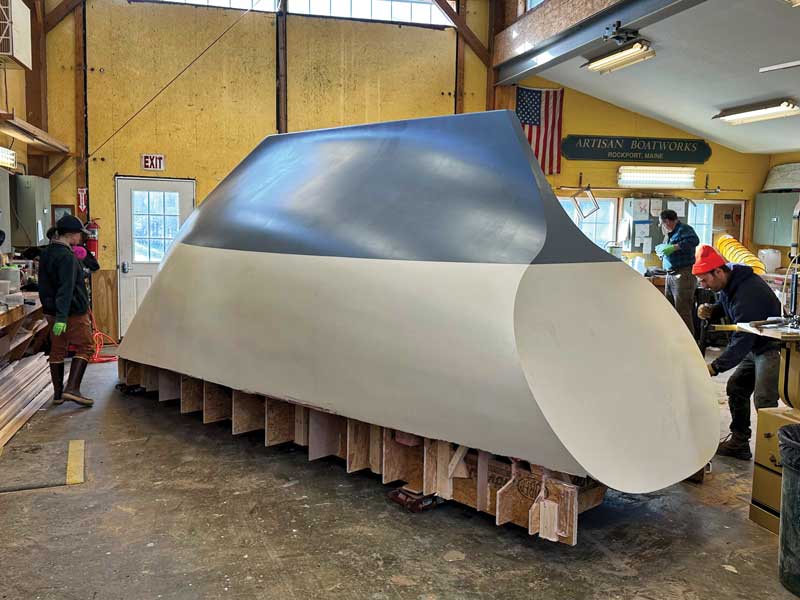 The Ha’ Penny 20 is designed to be a pocket cruiser capable of long voyages. Courtesy MacNaughton Yacht Designs
The Ha’ Penny 20 is designed to be a pocket cruiser capable of long voyages. Courtesy MacNaughton Yacht Designs
During a recent visit to Artisan Boatworks in Rockport, my attention was drawn to an unusual upside-down hull, strip planked, and ready for glassing. When I asked what it was, a young woman sweeping up planer shavings pointed out an outboard profile tacked up on the wall. The boat in the drawing looked like a version of transatlantic sailor Blondie Hasler’s Jester, with a single, junk rig, but prettier. Artisan is building this new boat for a sailor from the Midwest, who hoped initially to set a record for the smallest boat to sail around the world, but later settled for the concept of a modest voyaging yacht that can go anywhere.
Called the Ha’ Penny 20, the boat was designed by Tom MacNaughton of Eastport, Maine. At 20' 5/16" overall and just over 14 feet on the waterline, with a beam on deck of 7'2", the design, with its single junk rig, draws a bit over 3'7", and has a displacement of 5,403 lbs.
 The hull of the Ha’ Penny 20 under construction at Artisan Boatworks. Photo courtesy Artisan Boatworks
The hull of the Ha’ Penny 20 under construction at Artisan Boatworks. Photo courtesy Artisan Boatworks
I’ve wanted to write about MacNaughton’s work forever, not just for his character-filled boats, but also in recognition of his multifaceted contributions to yacht design. MacNaughton designs boats for amateur builders and sells stock plans. He also teaches an on-line school for yacht design and manages to provide comprehensive lessons about all phases of boat planning and construction, and ocean voyaging.
When I called R. W. Henson, the upside-down hull’s proud owner, in Minnesota, my first big question was whether Maine could anticipate some role in a new record for small boat voyaging. Henson didn’t answer that right away. But he noted that he had read more than 200 books about ocean voyaging and that an early influence was the book Dove, by Robin Lee Graham. Age 16 at the time, Graham was the youngest person in his day to embark on a voyage around the world. His sailing/romance/coming of age story, which was serialized in National Geographic, captivated the world of landlubbers and old salts alike, including me.
“The first book I ever read cover to cover was Dove,” Henson said. “Dove first lit the spark.”
Henson has had overlapping careers, as a firefighter, the owner of a towboat outfit on Cape Cod, and as a captain with a 100-ton license. His favorite sailing venue has been inland lakes in Maine during the fall. Henson learned about MacNaughton while exploring designs for a small and affordable cruiser that he could build himself. Several of the designer’s cute Chinese-junk-rigged “coin collection” designs with their numismatic names were candidates. For the past seven years he and MacNaughton have refined and reduced a design called the Shilling 22 down to the Ha’ Penny 20, which Henson argues is the ultimate tiny singlehander.
One glance at the design, inside and out, shows instances of MacNaughton’s less-is-more design sensibility. For instance, the Ha’ Penny 20 has just one sail, a junk rig, like the one on Blondie Hasler’s Jester. Hasler won the first singlehanded transatlantic race, later called the Observer Singlehanded Trans-Atlantic Race, and made many notable trans-ocean passages in Jester, a boat that he could reef and steer entirely from below.
Advantages of this rig include an unstayed mast, which means less rigging for gales to whistle through. Though a junk rig is reputed to be slow going to windward, it’s notoriously easy on the crew. And since it spreads force to either side of the mast, like a square rigger, it greatly aids self-steering. And MacNaughton contends a junk rig might also perform better to windward than one might think. “In recent years the discovery that the portion of the sail behind the raked yard was using ‘vortex lift,’ rather than foil lift has explained why a well designed gaff, lug, or Chinese rig might well be superior to windward even compared with a Marconi rig of good proportions. Pretty fascinating,” he wrote in an email.
The Ha’ Penny design features a huge rudder with a simple servo-type wind vane setup and a lead keel. There is no cockpit to flood, and at the owner’s insistence, no thru hulls. MacNaughton noted there will be little need for a life raft since the boat itself is akin to a sail-propelled lifeboat, but there is room for a small dinghy, or a kayak, on deck.
A boat with a 15-foot waterline length fully loaded won’t be fast, but if it steers without much effort, and sticks to the sailing trade routes, both wind and surface-drift will add a couple of knots to her 3.87 knot average speed. MacNaughton, who thrives on calculation, predicts that in the trades the Ha’ Penny might do about 5.19 knots or roughly 124 miles in a day. If the captain is unworried and has good sea legs and sea belly, he can configure the rig somewhat like a window blind, dropping or raising it to match sail area with conditions. Take away the motion and it actually sounds fun.
Construction is sheathed strip wood and epoxy. Artisans’ crew is following a method specified by MacNaughton, using square strip planks of Alaskan yellow cedar and unidirectional strand fiberglass, which is run vertical, inside and out. There’s a reinforcing bilge stringer, which will give the hull support if it’s laid over on a side, accidentally or on purpose. The spars will be carbon fiber, made by Forte. All of the plywood molds and bulkheads were cut on a CNC machine at Hewes & Company.
The small pilothouse has 6'6" of headroom, with panoramic views. Deep buttock lines, and the heavy displacement, allow for a low cabin floor and just over 5'8.5" of headroom under the flush deck. “This is enough for a 6'3" person to walk upright as long as they are looking down as they go,” according to MacNaughton.
Both MacNaughton and Henson wanted a small boat with heavy displacement. I’ve been on the ocean a lot, and for me, “small” while halfway to Bermuda, loses some luster when it’s under 40 feet. But if you’re seeking to minimize expense and maintenance by reducing size, then heavy displacement is critical. Just stowing enough food and water argues in favor of it. All the water in the Ha’ Penny will be stowed in plastic bottles on purpose-built shelves forward. This avoids the need for deck penetrations, and avoids the free-surface surge to leeward that can occur when water is stored in one or two large tanks.
 An interior view of the Ha’ Penny 20. Courtesy MacNaughton Yacht Designs
An interior view of the Ha’ Penny 20. Courtesy MacNaughton Yacht Designs
A good measure of the Ha’ Penny’s displacement is dedicated to creature comforts. There’s a charcoal burning stove, a decent sized galley, two 6'6" long berths with thick foam cushions, and lots of storage. Almost all the hardware is durable bronze. A Torqeedo electric outboard motor and Lithium battery are specified for entering port, and solar panels will perhaps provide enough power for that engine to provide headway in the doldrums. When we talked about alternatives to electric power I was informed that no fossil fuels were to be permitted aboard.
There is a “cassette” toilet, which is a modern and more dignified version of L. Francis’s bucket-and-chuck-it expedient.
It was a surprise to encounter a project like this at Artisan, which is known for its work building and maintaining ultra-premium yachts. Henson explained: “I decided instead of going cheap, that I’d minimize size and worries through years of careful design. And that when I had it built, I would surround myself with a real little yacht.”
At the end of our chat, I asked again about the singlehanded record. Henson confessed that Ha’ Penny will not be the smallest yacht to circumnavigate. That record was set in 1987 by someone sailing an 11'10" aluminum sloop. “Once I determined that a record for smallest vessel would be impractical for my enjoyment and living aboard, I focused on what design would give me the minimalist experience with the least amount of worries,” he explained. In addition, he is no longer planning a long cruise. “All those years I was aiming for the ultimate singlehander. But it always had room for two, and... I met someone.”
✮
Contributing Author Art Paine is a boat designer, artist, and writer living in Bernard, Maine.
Ha’ Penny 20
LOA: 20' 5/16"
LWL: 14' 10 3/16"
Beam on deck: 7' 2 1/32"
Beam on waterline: 6' 7 ¼"
Draft: 3’ 7 ¼"
Displ.: 5,403 lbs.
Sail area: 267.314 sq. ft.
Designer:
Tom MacNaughton
MacNaughton Yacht Designs
207-853-0071
macnaughtongroup.com
Builder:
Artisan Boatworks
416 Main St., Rockport, ME
207-236-4231
artisanboatworks.com






